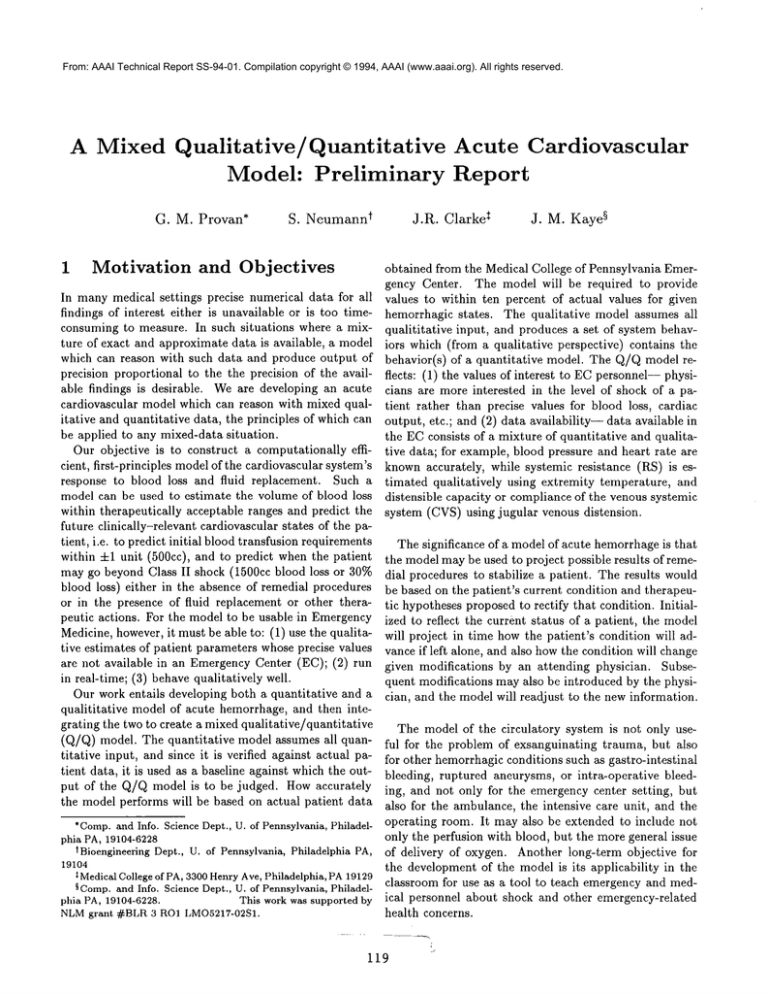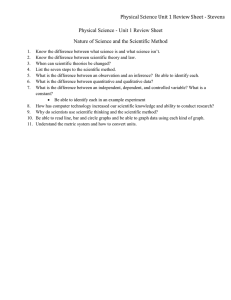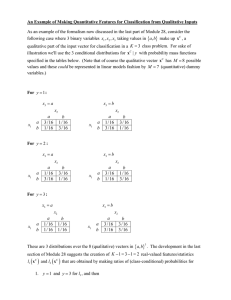
From: AAAI Technical Report SS-94-01. Compilation copyright © 1994, AAAI (www.aaai.org). All rights reserved.
A Mixed Qualitative/Quantitative
Model: Preliminary
G. M. Provan*
1
Motivation
tS. Neumann
and Objectives
In manymedical settings precise numerical data for all
findings of interest either is unavailable or is too timeconsuming to measure. In such situations where a mixture of exact and approximate data is available, a model
which can reason with such data and produce output of
precision proportional to the the precision of the available findings is desirable. Weare developing an acute
cardiovascular model which can reason with mixed qualitative and quantitative data, the principles of which can
be applied to any mixed-data situation.
Our objective is to construct a computationally efficient, first-principles modelof the cardiovascular system’s
response to blood loss and fluid replacement. Such a
model can be used to estimate the volume of blood loss
within therapeutically acceptable ranges and predict the
future clinically-relevant cardiovascular states of the patient, i.e. to predict initial blood transfusion requirements
within -t-1 unit (500cc), and to predict when the patient
may go beyond Class II shock (1500cc blood loss or 30%
blood loss) either in the absence of remedial procedures
or in the presence of fluid replacement or other therapeutic actions. For the model to be usable in Emergency
Medicine, however, it must be able to: (1) use the qualitative estimates of patient parameters whose precise values
are not available in an Emergency Center (no); (2)
in real-time; (3) behave qualitatively well.
Our work entails developing both a quantitative and a
qualititative
model of acute hemorrhage, and then integrating the two to create a mixed qualitative/quantitative
(Q/Q) model. The quantitative model assumes all quantitative input, and since it is verified against actual patient data, it is used as a baseline against which the output of the Q/Q model is to be judged. Howaccurately
the model performs will be based on actual patient data
*Comp.and Info. ScienceDept., U. of Pennsylvania,Philadelphia PA, 19104-6228
t Bioengineering
Dept., U. of Pennsylvania,Philadelphia PA,
19104
l MedicalCollegeof PA,3300HenryAve,Philadelphia,PA19129
§ Comp.and Info. ScienceDept., U. of Pennsylvania,Philadelphia PA,19104-6228.
This workwas supportedby
NLMgrant ~BLR3 RO1LMO5217-02S1.
Acute Cardiovascular
Report
*J.R. Clarke
§J. M. Kaye
obtained from the Medical College of Pennsylvania Emergency Center. The model will be required to provide
values to within ten percent of actual values for given
hemorrhagic states. The qualitative model assumes all
qualititative input, and produces a set of system behaviors which (from a qualitative perspective) contains the
behavior(s) of a quantitative model. The Q/Q model reflects: (1) the values of interest to ECpersonnel-- physicians are more interested in the level of shock of a patient rather than precise values for blood loss, cardiac
output, etc.; and (2) data availability-- data available
the ECconsists of a mixture of quantitative and qualitative data; for example, blood pressure and heart rate are
known accurately, while systemic resistance (RS) is estimated qualitatively
using extremity temperature, and
distensible capacity or compliance of the venous systemic
system (CVS) using jugular venous distension.
The significance of a model of acute hemorrhageis that
the modelmaybe used to project possible results of remedial procedures to stabilize a patient. The results would
be based on the patient’s current condition and therapeutic hypotheses proposed to rectify that condition. Initialized to reflect the current status of a patient, the model
will project in time howthe patient’s condition will advance if left alone, and also howthe condition will change
given modifications by an attending physician. Subsequent modifications may also be introduced by the physician, and the model will readjust to the new information.
The model of the circulatory system is not only useful for the problem of exsanguinating trauma, but also
for other hemorrhagic conditions such as gastro-intestinal
bleeding, ruptured aneurysms, or intra-operative bleeding, and not only for the emergency center setting, but
also for the ambulance, the intensive care unit, and the
operating room. It may also be extended to include not
only the perfusion with blood, but the more general issue
of delivery of oxygen. Another long-term objective for
the development of the model is its applicability in the
classroom for use as a tool to teach emergency and medical personnel about shock and other emergency-related
health concerns.
2
Acute Quantitative
cular Model
Cardiovas-
Of the many cardiovascular (CV) models created to date,
no published models consider acute hemorrhage in humans; interest has focused on steady-state conditions, or
return to steady-state after small perturbations are imposed upon the steady-state, to avoid having to deal with
numerous major nonlinear relationships simultaneously.
Under the conditions of acute hemorrhage, neither the
steady-state condition nor the long-term adaptation of
the cardiovascular system is of importance to patient
management. Rather, the transient responses of the CV
system are important, since they are necessary for answering questions about stabilizing victims after massive
blood loss: how soon may the patient go into shock, what
fluid replacement is necessary, and so on. Examining
physiologic processes during acute hemorrhage demands
a short time-scale for the model of minutes to hours.
In creating a model for acute hemorrhage, we have
taken two different approaches to develop the quantitative model of hemorrhagic response (the core model):
continuous flow approach [7] and a pulsatile flow approach
[1]. Each method provides advantages in analyzing what
is happening to the CVsystem, and our final quantitative model will be comprised of the most pertinent and
effective attributes of each method.
2.1
Continuous
Flow
Model
The continuous flow model best analyzes the system over
longer periods of time, from days to weeks. It determines
blood flow in a closed circuit through four compartments
(systemic arterial and venous, pulmonaryarterial and venous). The left and right heats are considered to close the
circulatory loop by uniting the four compartments. Blood
flows continuously throughout the system, from the left
heart to the systemic arterial, to the systemic venous, to
the right heart, to the pulmonary arterial, to the pulmonary venous, and back to the left heart (Figure 1).
sure changes, the baroreceptors sense the change, and
transmit a signal to the brain which responds by sending an efferent signal to the heart to modify its rate.
The baroreceptors also affect the resistance, resulting in a
negative feedback loop of regulated systemic blood pressure. Under conditions of steady-state, the influence of
the baroreflex may be represented by a sigmoidal curve.
However, hemorrhage induces a dynamic state in the cardiovasculature, and the sigmoid representation must be
modified accordingly. Also, the model must incorporate
a time-delay for the afferent and efferent transmission of
signals amongthe baroreceptors, the brain, and the heart.
Heart function is modeled in terms of parameters related to the heart’s contractile properties. The pressure
in the heart chamber is determined by the heart’s volume
and developed wall tension, which in turn is determined
by the mechanical properties of the muscle fibers. The
amountof blood that the ventricles pumpinto the arterial
system per unit time (the blood flow or cardiac output),
is equal to the product of the stroke volume (amount of
blood per beat) and heart rate.
Figure 1 depicts the closed, regulated cardiovascular
system. The left ventricle ejects blood flow QLand the
right ventricle, blood flow Qn. The systemic circulation
is represented by the arterial compliance CAS, the systemic peripheral resistance RS, and the venous systemic
distensible capacity CVS.Similarly, the pulmonary circulation consists of the pulmonaryarterial compliance CAP,
the pulmonary resistance l%P, and the pulmonary venous
compliance CVP.
2.2
Pulsatile
Flow
Model
The pulsatile flow model also determines flow in a closed
system. The system is larger, incorporating eight compartments, and is based on circuit theory. Resistors, capacitors, and diodes represent vascular resistance, compliance, and heart valves, respectively. This model operates
on a muchshorter time-scale, given it analyzes howblood
flow varies with each heart beat.
Flow through the system is determined by applying
Figure 1: Simplified Illustration of cardiovascular model Kirchhoff’s law around the circuit. Kirchhoff’s law states
Arterial
that the net flow at any point in the circuit is zero, and
CAS
"~
is upheld by setting the net flow at any point, zero, equal
to the sum of all flows entering or exiting that point.
The two mathematical definitions of flow employed by
the model are (1) pressure difference divided by resistance, and (2) compliance times change of pressure with
cvs
time. A set of ordinary differential equations, solved si/
Systemic
multaneously using an euler numerical solution, indicates
how pressure, and thus volume and flow, varies over time
Baroreceptors in the aortic sinus and aortic arch regu- in each of the eight compartments.
late short-term systemic arterial pressure. As blood presCritical to the mechanics of this model is the time-
QL\
varying compliance of the ventricles. The ventricular
compliance varies dramatically over the course of each
heart beat, and in modeling this phenomenon, in conjunction with the opening and closing of heart valves,
blood flows not continuously (as in the continuous flow
model) but rather in a pulsatile manner. Simulation of
valve positions is achieved by varying the resistance the
valves impose upon the system (0.001 mmHgsec/cc for
an open valve, 1000 mmHgsec/cc for a closed valve). As
valves do not open and close instantaneously, the resistances of the diodes gradually change over a time-scale
appropriate for heart valves.
Currently, with the exception of the ventricular compliances and the diodes, all resistances and compliance values are constant in the model. However, physiologic parameters whose functioning changes dramatically during
acute hemorrhage must be identified, and means by which
to represent their variations designed into the model.
Such parameters include blood viscosity, muscular compliance (for containing hemorrhaged blood which has entered intravascular spaces), time-varying ventricular compliances, and the influence of various catecholamines released during hemorrhage. Physiologic parameters currently defined as constant in the modelwill be redefined as
variable to be able to respond to extreme changes brought
on by acute hemorrhage. Algorithms which define how
these parameters vary and respond to changes will necessarily be designed and implemented.
contained within a range value. Third, functions can be
expressed either precisely as in CO= HRx SV or using
qualitative functions. For example, CO(cardiac output)
varying monotonically with HR(heart rate) is represented
as CO = M+(HR). + t hus d efines a cl ass of functions
which relate the independent and dependent variables
monotonically. Additional qualitative functional relationships can be specified, such as the M- inverse monotonic
relationship.
Wehave been developing a general constraint-based
simulation tool, QobiSIM[9], that is built on a constraint
programming language,
SCREAMER[8]. SCREAMER
accepts both qualitative and quantitative variables and
constraints on variables, allowing development of a mixed
qualitative/quantitative
simulation tool which offers advantages over existing qualitative/quantitative
simulation
tools, including efficiency, generality and ease of use.
Tests on several large qualitative models (e.g. chemical
reactors with non-linear proportional integral controllers)
have proven the ability of QobiSIMto match the results
of the well-knownsimulator QSIM[5], thus verifying the
soundness of the implementation.
A first-cut simulation of the continuous flow cardiovascular model has been implemented. The qualitative
model is shown in Figure 2.
The time scale for the model is on the order of minutes
to hours, in contrast to the seconds to minutes of the pulsatile cardiovascular model of [10], or the days to months
of the water balance/CV mechanisms of [4].
Creating this model involved converting the set of or3 Acute Qualititative
Cardiovas- dinary differential equations (ODEs) which define the
core model into an equivalent set of qualitative differcular Model
ential equations (QDEs). This set of QDEs is guarQualitative reasoning [12, 11] permits systems to be sim- anteed not to produce any unsound system behaviors;
ulated when not all system parameters are known pre- however, it produces several spurious system behaviors,
cisely. For example, in a cardiovascular simulation, sys- e.g. behaviors which differ only in unimportant variables,
such as 18t and 2rd-order derivatives. Reducing such untemic peripheral resistance (RS) is typically specified
"low", "normal" or "high" based on extremity tempera- wanted behaviors requires defining additional constraints,
ture. Such qualitative values can be used to simulate the such as constraints on higher-order derivatives, quantibehaviors of the CVsystem.
tative constraints, etc. Further work is needed in this
Qualitative simulators bear manyresemblances to their area: the purely qualitative model provides output that
roughly mirrors the quantitative model, although better
quantitative counterparts, but there are some significant
differences. First, variables in qualitative simulators may constraints are needed to improve its performance and
1
take either qualitative point values, called landmarks(e.g. accuracy, and to avoid generating spurious behaviors.
The types of simulations which are being run are:
RS = low), or range values between adjacent landmarks
( RS E low - normal). Each variable is associated with
Steady state: this models the CVstate when all state
a quantity-space, which defines the domain of possible
values for the variable, e.g. (low, low-normal, normal,
variables are stable;
normal-high, high). Second, time in qualitative simulators is represented as a sequence of instants and interStep decrease in Blood Volume: this models the efvals. Variables maychange values only at transitions befect of blood loss over a short time period;
tween time steps; during time intervals values are either
1 Suchproblemsare inherent in M1purely quMitativemodels.
assumed to remain constant at a point value or to be
121
Leak: this models a person who is losing blood over a
period of time;
Infusion: this models the effect of an infusion on a person who may or may not be losing blood.
While the focus of this investigation is to develop our
mixed Q/Qmodel for acute cardiovascular activity, we intend, as an application of this project, to couple the acute
qualitative cardiovascular model with models of other
physiological systems, such as respiration. Currently, we
are also developing a simple, qualitative model for respiration centered on the physical changes that occur during
inhalation and exhalation. Our aim in coupling physiological systems is part of our goal to provide a simplified global model that integrates anatomical disruption
with physiological change. Weare designing our global
model to capture the physical properties of anatomical
parts, their spatial interactions, and their physiology and
pathophysiology.
Figure 2: Simplified Illustration of qualitative cardiovascular model. Each of the three "systems" (heart, arterial
and venous) has its own values for compliance (C), blood
volume (BV) and blood pressure (BP)
C,
BV,~
~x~BV,
C. BV.BP
4
Mixed
Quantitative
BP
C. BV,BP
QualitativeModel
Creating the mixed qualitative-quantitative
model involves integrating quantitative constraints into the qualiitative model. Incorporating quantitative constraints can
122
significantly decrease run-time and spurious behaviors in
a purely qualitative model[2, 6]. To the extent possible,
we plan to use such numerical constraints from the quantitative core model. The goal is to produce a model which
can use either qualitative or quantitative input, as the
data is available. Wewill take advantage of the built-in
numerical constraint-solving
techniques in SCI~EAMER
(e.g. for real-valued non-linear equations and interval
arithmetic) to solve the quantitative constraints. This is
similar to the integration of information from numerical
simulation of differential equations into qualitative models [3]. There are several other techniques developed by
quantitative extenstions to QSIM[6] and QPE[2] which
can also be used.
We argue that there are many medical domains in
which mixed Q/Q models are necessary, and that the
principles embodied in QobiSIMwill be applicable to all
such domains.
References
[1] K. Campbell,M. Zeglen, T. Kagehiro, H. Rigas A Pulsatile
Cardiovascular ComputerModelfor Teaching Heart-Blood
Vessel Interaction. The Physiology Teacher, 25(3), 1982,
pp. 155-162.
[2] K. Forbus and B. Falkenhainer. Self-Explanatory Simulations: An Integration of Qualitative and Quantitative
Knowledge.In Proc. AAAI, pages 380-387, 1990.
[3] H. Kay and B. Kuipers. NumericalBehavior Envelopes for
Qualitative Models. in Proc. AAAI, 1993.
[4] B. Kuipers. Qualitative Simulation as Causal Explanation.
IEEE Trans Syst. Manand Cyb., 17:432-444, 1987.
[5] B. Kuipers. Qualitative Simulation. Artificial Intelligence,
29:289-338, 1986.
[6] B. Kuipers and D. Berleant. Using Incomplete Quantitative Knowledgein Qualitative Reasoning. In Proe. AAAI,
pages 324-329, 1988.
Modeling, Simulation and Parameter[7] D. Mhller
Estimation of the HumanCardiovascular System. Friedr.
Vieweg ~ Sohn, Braunschweig/Wiesbaden,1983.
J.
Siskind and D. MeAllester. Nondeterministic Lisp as a
[8]
Substrate for Constraint Logic Programming.Proc. AAAI,
pages 133-138, WashingtonD.C., July 1993.
[9] J. Siskind and G. Provan. A Constraint-Based Qualitative
Simulation System. unpublished technical report, University of Pennsylvania, Dept. of CIS, forthcoming.
[10] P. Toal and J. Hunter. A Qualitative Modelof Cardiac
Haemodynamics.Technical Report AUCS/TR-9001,University of Aberdeen,Dept. of ComputingScience, 1990.
[11] D.S. Weldand J. de Kleer. Readingsin Qualitative Reasoning About Physical Systems. MorganKaufmann,1989.
[12] B. Williamsand J. de Kleer. Qualitative Reasoningabout
Physical Systems: a Return to Roots. Artificial Intelligence, 51:1-9, 1991.







